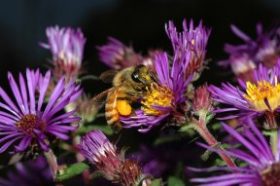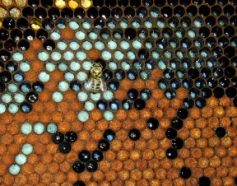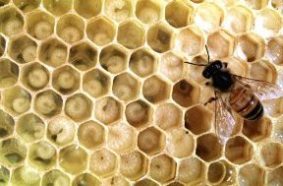Decoding how bees work
Analyzing the DNA code of honeybees may lead to a better understanding of bee societies.
By Emily Sohn
Bees have a lifestyle that would be difficult for people to imitate. Like termites and ants, only a few members of the group have babies, but everyone else chips in to work and take care of the little ones.
Scientists have long wondered what makes these super-social insects tick. Now, they have some important clues. A group of researchers has recently decoded the genome, or entire set of genes, of the western honeybee.
 |
|
A honeybee visits an aster.
|
| Zachary Huang |
Genes are made of the molecule DNA, which is like an organism’s operating manual. By looking at what genes an animal has and what they do, scientists can learn a lot about the biology behind its behavior.
The new work is especially exciting because it’s the first time that researchers have decoded the genome of a creature with a queen-and-worker society.
“The sequencing of the honeybee genome is unquestionably a historic event,” says Ben Oldroyd, a bee specialist at the University of Sydney in Australia.
 |
|
A western honeybee worker tends larvae, one of the social behaviors that makes the insect’s DNA code so intriguing to biologists.
|
| Ryszard Maleszka |
In addition to honeybees, geneticists have so far unraveled the genomes of four other insect species: malaria mosquitoes, silkworms, and two types of fruit flies. New comparisons among the groups have revealed a number of surprises.
Honeybees, for instance, have 170 genes for sensing smells. Fruit flies have only 60. Apparently, it helps to have a good sniffer when you live a bee’s life.
Compared to fruit flies and malaria mosquitoes, on the other hand, honeybees have far fewer genes to support their immune systems, which defend against disease. That’s surprising because animals that live in groups tend to encounter more diseases.
Honeybee genes share some traits with the genes of vertebrates (animals with backbones). For example, both honeybees and vertebrates, including you and me, use the same kind of genes for establishing body rhythms that depend on the time of day. They also have similar genes for switching other genes on and off.
 |
|
A worker bee tends larvae.
|
| Jeff Pettis, USDA-ARS Bee Research Lab |
Bees have small, simple brains, but they’re able to learn and remember far more than you might expect. The decoding of the honeybee genome might help explain these amazing behaviors.
The new work might also help scientists breed stronger bees. Over the last 20 years, tiny pests have arrived that kill a lot of honeybees. Up to one third of commercial honeybees in the United States have disappeared.
That’s a problem for us, too. Honeybees carry pollen around so that plants can make a lot of the food we eat, from apples to zucchini.
Going Deeper:
Milius, Susan. 2006. Genome buzz: Honeybee DNA raises social questions. Science News 170(Oct. 28):275. Available at http://www.sciencenews.org/articles/20061028/fob1.asp .
You can learn more about the western honeybee at www.gpnc.org/honeybee.htm (Great Plains Nature Center) and en.wikipedia.org/wiki/Western_honeybee (Wikipedia).
For information about the honeybee genome, go to www.news.uiuc.edu/news/06/1025robinson.html (University of Illinois at Urbana-Champaign) and www.ncbi.nlm.nih.gov/genome/guide/bee/ (National Institutes of Health).
Sohn, Emily. 2005. Bee heat cooks invaders. Science News for Kids (Sept. 28). Available at http://www.sciencenewsforkids.org/articles/20050928/Note2.asp .
______. 2005. Copybees. Science News for Kids (Sept. 7). Available at http://www.sciencenewsforkids.org/articles/20050907/Note3.asp .
_____. 2005. Little bee brains that could. Science News for Kids (April 6). Available at http://www.sciencenewsforkids.org/articles/20050406/Note2.asp .
______. 2003. Childhood chills give bees six left feet. Science News for Kids (May 28). Available at http://www.sciencenewsforkids.org/articles/20030528/Note2.asp .
Science project idea: Test honeybee memory. See www.hometrainingtools.com/articles/bee-memory-experiment.html (Home Training Tools).
For information on genomics projects, go to www.sciencebuddies.org/mentoring/project_ideas/
home_Genom.shtml?from=Home (Science Buddies).







